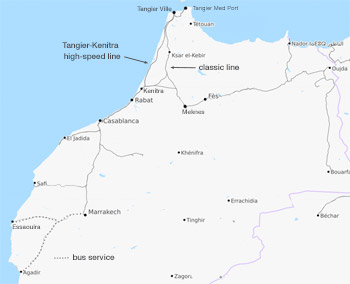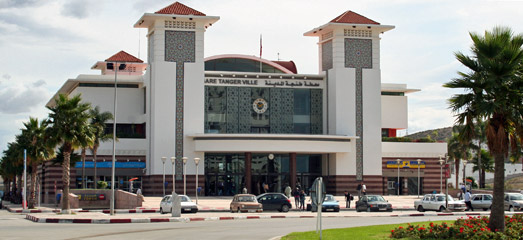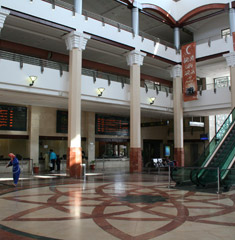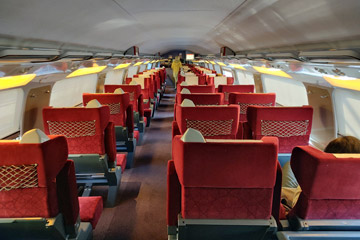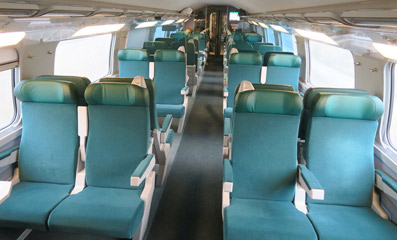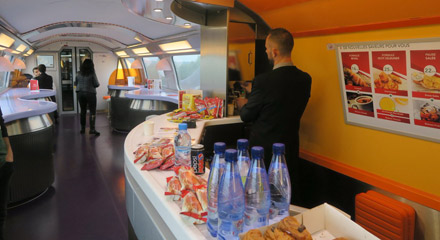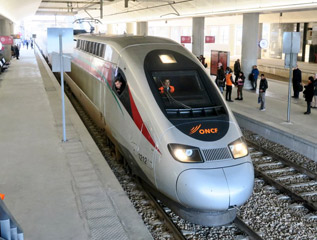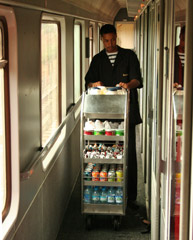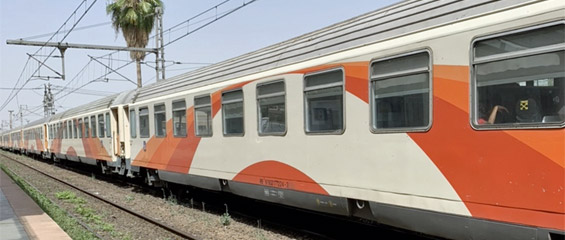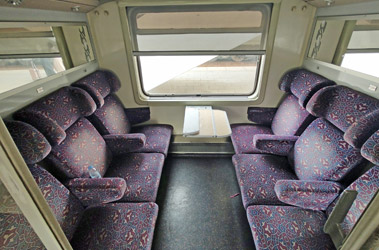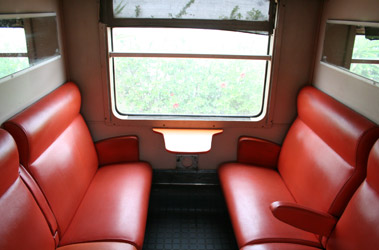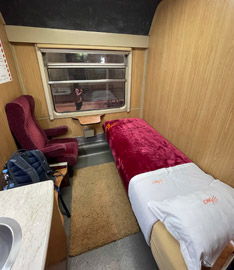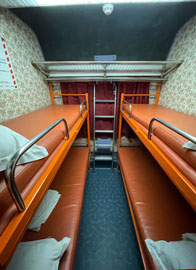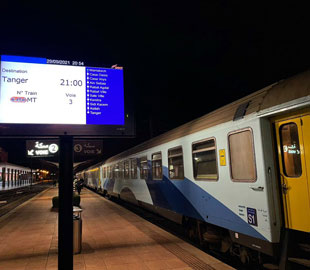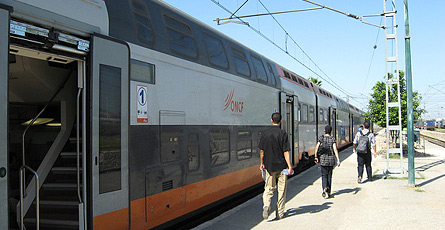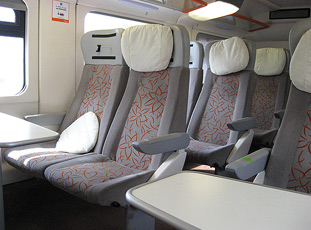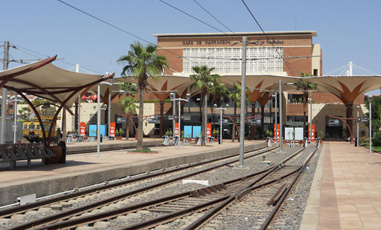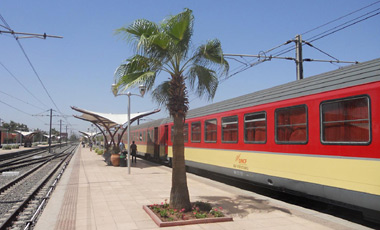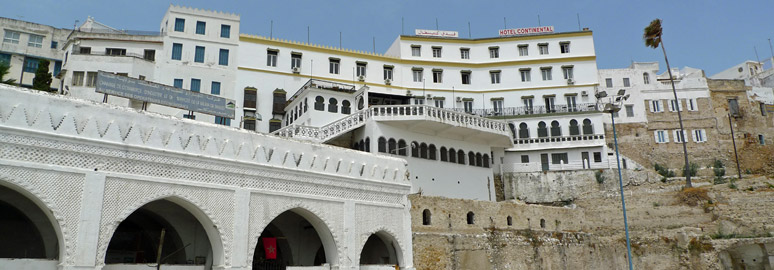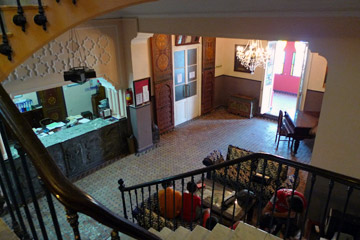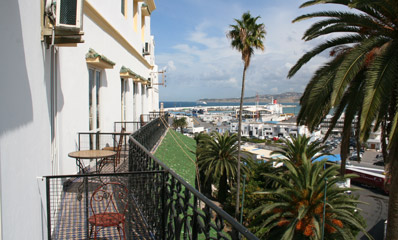Route map |
The best way to get around Morocco
The best way to travel between Moroccan cities is by train. Morocco now has Africa's fastest trains, 300km/h (186mph) Al Boraq high-speed trains based on France's TGV, linking Tangier, Rabat & Casablanca every hour over a new high-speed line. Classic trains link Tangier & Casablanca with Meknes, Fes & Marrakech.
![]() Taking the train south from
Tangier
Taking the train south from
Tangier
![]() What are Moroccan trains like?
What are Moroccan trains like?
![]() How to travel from London & Paris to
Morocco by train
How to travel from London & Paris to
Morocco by train
Where do the trains go?
-
The new high-speed line runs Tangier-Rabat-Casablanca. Classic lines run Tangier-Meknes-Fes, and Fes-Meknes-Rabat-Casablanca-Marrakech. A bus connection links Marrakech with Agadir & Essaouira. See train route map at openstreetmap.com.
How to buy tickets
-
Option 1, buy at the Moroccan Railways (ONCF) website www.oncf-voyages.ma
Booking opens 3 months before departure, increased from one month in 2022.
Tip: At the time I write this you need a VPN set to Morocco to access it, this has not always been the case and could be temporary.
Click English top right. You cannot book couchettes or sleepers online, only seats.
Fares are cheap by European standards, see fare examples below. Fares for the Al Boraq high-speed trains have variable pricing in 2nd class, with cheaper advance-purchase non-flexible fares and more expensive flexible fares. This policy has now been extended to most conventional long-distance trains too, which have been branded Al Atlas. At short notice the more expensive flexible fares will apply.
Children aged 0-3 travel free, children aged 4-10 travel at half fare, children aged 11 and over pay the adult fare.
It originally only accepted Moroccan credit cards, it should now accept most non-Moroccan cards. If it rejects your card check with your bank and /or try another card, or use 12go.com instead.
-
Option 2, buy online at 12go.com
You can buy Moroccan train tickets online in English at 12go.com, a reliable train, ferry & bus booking agency.
12go.com accepts overseas payment cards, no problem.
-
Option 3, buy online at www.bookaway.com
You can also buy Moroccan train tickets online in English at www.bookaway.com, another reliable train, ferry & bus booking agency, also without any payment problems.
-
Option 4, buy at the station
It's easy enough to buy your ticket at the station on the day or perhaps the day before. Tangier Ville station now accepts credit cards as well as cash. If booking couchettes or sleepers they need to see your passport as this counts as overnight accommodation.
On both the Al Boraq high-speed trains and the classic Al Atlas trains, all tickets come with a reserved seat so trains can in theory sell out, but there are so many seats that in practice they seldom do. The Al Atlas trains have only one first class car, and that can indeed sell out on occasion.
The shuttle trains (Trains Navettes Rapides) linking Rabat & Casablanca and the few remaining conventional long-distance trains which have not yet been branded Al Atlas have unreserved 2nd class where tickets do not include a reserved seat so tickets cannot sell out, you sit where you like on a first come, first served basis.
-
How to book a sleeper from Tangier to Marrakech
Sleeping-berths on the convenient Tangier-Marrakech overnight train can be reserved up to 2 months in advance. These sometimes get fully-booked as there's only one couchette car on the train, but it's reportedly sometimes possible to find berths available on the day of travel.
Unfortunately, the couchettes cannot be booked online. To book a couchette, contact agencies www.marrakechtickets.co.uk or www.travellink.ma as suggested below.
-
Buy from outside Morocco through these local agencies
If it's mission-critical to book a specific train, or you want a couchette on the Tangier-Marrakech night train, contact one of these agencies:
Marrakech Tickets: www.marrakechtickets.co.uk - tickets for daytime trains can be emailed to you, tickets for the overnight couchette train can be collected in Marrakech or for departures from Tangier couriered to you for around £35.
Travel Link: One seat61 correspondent suggests arranging couchette tickets on this train through local travel agency Travel Link (www.travellink.ma, 83 Rue de la Liberté (next to the El Minza Hotel), Tanger, call +212 539 93 58 77 or email both officetanger@travellink.ma & imad@travellink.ma, though reports about this agency have been mixed, see below. You can also try similar agency www.andotravel.com.
Taking the train from Tangier
Tangier to Rabat
-
Journey time 1h20 by Al Boraq high-speed train.
-
Departures from Tangier at 06:00 and every hour until 19:00, then 21:00.
Rabat Agdal is the station where the high-speed Al Boraq trains arrive, Rabat Ville is only served by classic non-high-speed trains.
-
Fares vary between 89 & 172 dirhams in 2nd class, 129 & 224 dirhams in 1st class.
Tangier to Casablanca
-
Journey time 2h10 by Al Boraq high-speed train.
-
Departures from Tangier at 06:00 then every hour until 19:00, 21:00.
Casa Voyageurs is the station where the high-speed trains arrive.
-
Fares vary between 99 & 224 dirhams in 2nd class, 129 & 292 dirhams in 1st class.
-
Alternatively, there's a direct overnight train, leaving Tangier at 23:25, arriving Casablanca 06:10.
The train has an air-conditioned 1st class couchette car with shared 4-berth compartments & 2nd class air-conditioned seats cars, see the Tangier-Marrakech overnight train section below.
The fare is around 375 dirhams in a shared 1st class 4-berth couchette or from 399 dirhams in advance or 670 dirhams full-price for a private single-berth compartment in the sleeping-car.
Tangier to Marrakech
-
Option 1, by daytime train: Take an Al Boraq high-speed train from Tangier to Casa Voyageurs, then a classic Al Atlas train from Casa Voyageurs to Marrakech.
Departures from Tangier at 06:00, 08:00, 11:00, 14:00, 15:00, 17:00, 19:00. Journey time around 5h14.
Fares vary between 186 & 338 dirhams in 2nd class, between 249 & 472 dirhams in 1st class.
-
Option 2, by direct overnight train, leaving Tangier at 23:25, arriving Marrakech 09:01.
The train has an air-conditioned 1st class couchette car with shared 4-berth compartments & 2nd class air-conditioned seats cars, see the Tangier-Marrakech overnight train section below.
The fare is 216 dirhams in a 2nd class seat, around 375 dirhams in a shared 1st class 4-berth couchette or from 399 dirhams in advance or 670 dirhams full-price for a private single-berth compartment in the sleeping-car.
Tangier to Meknes & Fes
-
Option 1, journey time around 2h40 to Meknes or 3h25 to Fes, taking an Al Boraq high-speed train from Tangier to Kenitra and changing onto a classic Al Atlas train eastwards to Fes. Departures from Tangier at 06:00, 07:00, 08:00, 09:00, 10:00, 11:00, 12:00, 14:00, 15:00, 16:00, 17:00, 18:00.
-
Option 2, journey time around 3h40 to Meknes or 4h13 to Fes by direct Al Atlas train over the classic line from Tanger to Fes. Departures at 07:40, 11:35, 14:30, 19:05.
Bus connection to Agadir & Essaouira
-
Buses link Marrakech with Agadir roughly every hour or so, journey time 3h30. Buses link Marrakech with Essaouira ever 2-3 hours, journey time 3h. You can check bus times at www.oncf-voyages.ma.
-
Buses are run by Supratours, a subsidiary of Moroccan railways. Buses leave from the Supratours terminal next to Marrakech railway station, so train-bus connection is easy.
-
Marrakech - Agadir costs about 110 dirhams (€10), it costs a bit less to Essaouira. Luggage must be checked in, and a small fee of around 5 dirhams is payable for this in addition to your fare.
-
Buy tickets locally. You can buy combined train+bus tickets from any Moroccan railway station to Agadir via Marrakech - ask for a billet rail et route.
Tangier Ville station
The old station in Tangier near the port & medina was closed some years ago and is now used as a police station. An impressive new Tanger Ville station has been built just inland from the far end of the sea front. It's now been expanded to accommodate the Al Boraq high-speed trains. Walking from the port, the medina or the Continental Hotel to the new station takes around 30-35 minutes, so take a petit taxi as this only costs 20 dirhams or so (about £1.70). The station includes a comfortable Al Boraq lounge for anyone with a 1st class Al Boraq ticket.
What are Moroccan trains like?
Al Boraq high-speed trains
Africa's first high-speed trains started running in November 2018 on the new Tangier-Rabat-Casablanca high-speed line. Morocco's Al Boraq high-speed trains are 300km/h (186mph) double-deck trains, a version of French Railway's TGV Duplex. They have 1st & 2nd class and a cafe-bar. The new line roughly follows the route of the (still-operating) classic line, but joins the Fes-Casablanca main line at Kenitra rather than Sidi Kacem.
Tip: There is an Al Boraq lounge for anyone with a 1st class Al Boraq ticket at Tangier Ville, Kénitra, Rabat Agdal and Casablanca Voyageurs
Classic Al Atlas trains
The classic long distance trains have smooth-riding 1st & 2nd class air-conditioned coaches, with a trolley selling tea, coffee, sandwiches & snacks. Most of these classic expresses are now branded Al Atlas, with a reserved seat included with every ticket. The few remaining classic expresses which have not yet been branded Al Atlas have reserved seats in 1st class but no reservation possible in 2nd class.
Overnight train from Tangier to Marrakech
The overnight train is a popular and time-effective way to travel from Tangier to Marrakech, sleeping in a couchette and saving a night in a hotel. Until early 2022, the train had one sleeping-car with single-berth compartments and one couchette car with 4-berth compartments, but the sleeping-car has now reportedly been discontinued. Only the 1st class 4-berth couchettes remain.
The couchette car has 11 shared 4-berth compartments, each berth provided with pillow, sheet and light blanket. The car is air-conditioned, although it may be a while before the air-con kicks in if the car has been standing in the sidings all day.
For the record - and in case it resumes at some point - the sleeping-car had 11 private single-berth compartments (Lit Single in French), each with a comfy bed with full bedding, a washbasin and a chair. The sleeper was a relatively new addition, introduced in 2018 although the car itself is older. But like I said, it's been discontinued.
Couchettes can get sold out, so book ahead if you can. However, it's not impossible to find berths available even if you book at the station on the day of travel, so give it a try. The couchettes can't be booked online, to book a couchette in advance from outside Morocco, see the specific advice on this train in the How to buy tickets section above.
Double-deck trains between Rabat & Casablanca...
These smart air-conditioned double-deck trains operate the hourly Rabat-Casablanca shuttle service (TNR or Train Navette Rapide, they also operate a few Fez-Meknès-Rabat-Casablanca expresses.
Guidebooks
Make sure you take a good guidebook. Easily the best guidebooks for the independent traveller are Lonely Planets and Rough Guides. Both provide an excellent level of practical information and historical background. You won't regret buying one of these!
Click the images to buy at Amazon.co.uk
 |
 |
Hotels in Morocco
In Tangier, the classic Continental Hotel is the top choice for location and atmosphere, and inexpensive, too. Ideally located for both port and old medina, and with its own restaurant, it can now be booked online at Booking.com. Opened in 1870, Winston Churchill stayed there, amongst others. Update 2025: It's closed for refurbishment, but may reopen at some stage.
In Marrakech, the Hotel Islane is a good mid-range choice at around €35-€45 (£26-£31) per room per night, with an excellent central location just round the corner from the Jemaa el Fnaa, the main market square. It also has a good rooftop restaurant. The most famous hotel in Marrakech is of course the top-notch La Mamounia Hotel, if you can (a) afford it and (b) get a room!
You can arrange hotels before booking opens for train tickets if you use a site with free cancellation such as www.booking.com.
Backpacker hostels...
www.hostelworld.com: If you're on a tight budget, don't forget about backpacker hostels. Hostelworld offers online booking of cheap private rooms or dorm beds in backpacker hostels in most cities at rock-bottom prices.
Car hire in Morocco
It's well worth hiring a car south of Marrakech! Hiring a car isn't the first thing you'd think of in Morocco, but the roads are relatively empty and driving is surprisingly easy. If you've a few days to spare when you get to Marrakech I highly recommend hiring a car and driving south over the High Atlas Mountains via the absolutely incredible Tizi n Tichka Pass, perhaps the most amazing road I've ever driven. Stay the night at the Kasbah at Tifletout (now a hotel) and visit the Gorge du Dadès, Todra Gorge, and the remarkable mud-built town of Aït ben Haddou. Driving really isn't difficult, indeed the roads are far less crowded than in the UK or Europe, making it a very pleasant way to get around the countryside. Instead of searching multiple websites to sort out your car, try this search engine which compares different hire companies' prices.
Compare 50 different car hire companies: www.carrentals.co.uk
Travel insurance & VPN
Always take out travel insurance
You should take out travel insurance with at least £1m or preferably £5m medical cover from a reliable insurer. It should cover trip cancellation and loss of cash & belongings up to a reasonable limit. These days, check you're covered for covid-19-related issues, and use an insurer whose cover isn't invalidated by well-meant but excessive Foreign Office travel advice against non-essential travel. An annual policy is usually cheapest even for just 2 or 3 trips a year, I have an annual policy with Staysure.co.uk myself. Don't expect travel insurance to bail you out of every missed connection, see the advice on missed connections here. Here are some suggested insurers, I get a little commission if you buy through these links, feedback always welcome.
![]() www.staysure.co.uk
offers enhanced Covid-19 protection and gets 4.7 out of 5 on
Trustpilot.
www.staysure.co.uk
offers enhanced Covid-19 protection and gets 4.7 out of 5 on
Trustpilot.
![]() www.columbusdirect.com is also a well-know brand.
www.columbusdirect.com is also a well-know brand.
![]() If you live in the USA try
Travel Guard USA.
If you live in the USA try
Travel Guard USA.
Get an eSIM with mobile data package
Don't rely on WiFi, download an eSIM with a European mobile data package and stay connected. Most newer mobile phones can download a virtual SIM including iPhone 11 & later, see device compatibility list. There's no need to buy a physical SIM card! Maya.net is a reliable eSIM data retailer with a 4.5 out of 5 Trustpilot rating and a range of packages including unlimited data.
Get a Curve card for foreign travel
Most banks give you a poor exchange rate then add a foreign transaction fee on top. A Curve MasterCard means no foreign transaction fees and gives you the mid-market exchange rate, at least up to a certain limit, £500 per month as I write this. The money you spend on your Curve card goes straight onto one of your existing debit or credit cards. And you can get a Curve card for free.
How it works: 1. Download the Curve app for iPhone or Android. 2. Enter your details & they'll send you a Curve MasterCard - they send to the UK and most European addresses. 3. Link your existing credit & debit cards to the app, you can link up to two cards with the free version of Curve, I link my normal debit card and my normal credit card. 4. Now use the Curve MasterCard to buy things online or in person or take cash from ATMs, exactly like a normal MasterCard. Curve does the currency conversion and puts the balance in your own currency onto whichever debit or credit card is currently selected in the Curve app. You can even change your mind about which card it goes onto, within 14 days of the transaction.
I have a Curve Blue card myself, it means I can buy a coffee on a foreign station on a card without being stung by fees and lousy exchange rates, just by tapping the Curve card on their card reader. The money goes through Curve to my normal debit card and is taken directly from my account (in fact I have the Curve card set up as payment card on Apple Pay on my iPhone, so can double-click my phone, let it do Face ID then tap the reader with the phone - even easier than getting a card out). I get a little commission if you sign up to Curve, but I recommend it here because I think it's great. See details, download the app and get a Curve card, they'll give you £5 cashback through that link.
Get a VPN for safe browsing. Why you need a VPN
When travelling you may use free public WiFi which is often insecure. A VPN encrypts your connection so it's always secure, even on unsecured WiFi. It also means you can select the geographic location of the IP address you browse with, to get around geoblocking which a surprising number of websites apply. See VPNs & why you need one explained. ExpressVPN is a best buy with a 4.7 out of 5 Trustpilot ranking which I use myself - I've signed up as an ExpressVPN affiliate, and if you go with expressvpn.com using this link you should see a special deal, 3 months free with an annual subscription. I also get some commission to help support this site.
Carry an Anker powerbank
Tickets, reservations, hotel bookings and Interrail or Eurail passes are often now held on your mobile phone. You daren't let it run out of power, and you can't always rely on the phone's internal battery or on being near a power outlet. I always carry an Anker powerbank which can recharge my phone several times over. Buy from Amazon.co.uk or buy from Amazon.com.
Touring cities? Use hill walking shoes!
One of the best things I've done is swap my normal shoes for hill-walking shoes, in my case from Scarpa. They're intended for hiking across the Pennines not wandering around Florence, but the support and cushioning for hiking works equally well when you're on your feet all day exploring foreign cities. My feet used to give out first and limit my day, now the rest of me gives up before they do!


